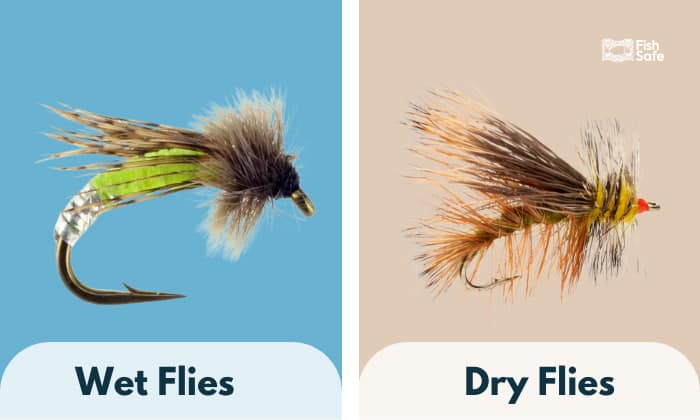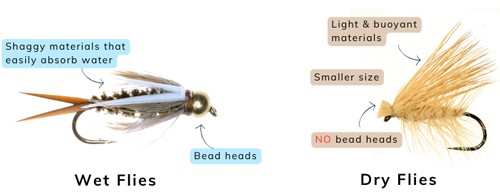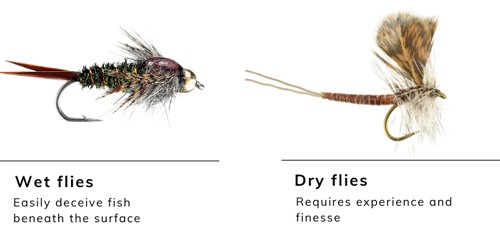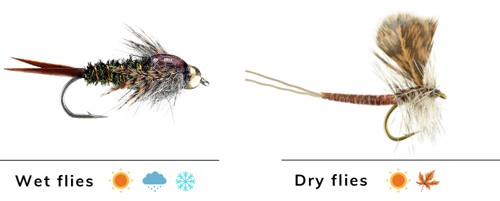The debate over wet flies vs dry flies intrigues novice and expert anglers. Yet, understanding the main differences between these two central players can vastly improve your catches.
Dry flies are designed to imitate insects on the water’s surface, making an attractive meal for surface-feeding fish. Meanwhile, wet flies sink below the surface and they mimic subsurface life to lure fish that prey underwater.
This post will explore the difference between wet and dry flies, enhancing your fishing strategy.
Before we dive into details, here’s a quick summary of the distinctions between these two types of fly fishing lures:
| Wet Flies | Dry Flies | |
| Position in water | Sink below the surface | Float on the surface |
| Imitation | Mimics subsurface insects and larvae | Mimics insects and surface-dwelling insects |
| Fly material | Heavier materials, may use added weight | Lighter and buoyant materials |
| Casting distance | Longer | Shorter |
| Casting technique | Easier | More difficult |
Page Contents
Understanding Wet Flies and Dry Flies
In fly fishing, particularly for trout, understanding wet and dry flies is essential.
A wet fly is designed to sink below the water’s surface, mimicking the subsurface life that includes insects in various life stages. They imitate the appearance of aquatic insects inhabiting the underwater environment.
You can find such lures include nymphs, crawfish, leeches, wooly buggers, and small fish.
Meanwhile, dry flies, as the name suggests, stay dry and remain on the water’s surface. It emulates a variety of surface life, including adult insects or those trapped in the surface film.
Grasshoppers, mayflies, and beetles are some dry flies that many anglers like to use.
Differences Between Wet and Dry Flies
Seasoned and novice anglers must understand the fundamental differences between wet and dry flies. Consider the following elements:
1. Their look
If you’re shopping for lures online or in a tackle store, you can tell a dry fly from a wet fly through their physical looks.
- Wet flies are typically designed with heavier materials, often incorporating additional weights such as copper wires or bead heads. They’re primarily made of soft and shaggy materials that easily absorb water.
Furthermore, these flies are longer. Plus, wet flies are mostly attached to weighted hooks. Often, they come in vibrant colors to help attract fish.
- Meanwhile, dry flies are made using lighter materials. They may employ buoyant materials (foam, feathers, or hair) to help them resist water and stay afloat.
Unlike wet flies, these don’t have bed heads and may appear buggy. Also, dry flies are generally smaller in size than wet flies.
2. Ease of use
Fishing with dry flies requires experience and finesse to be successful. If trout sense your fly isn’t a legitimate food source, they won’t take a bite. It could startle your target fish and trigger a mass scattering across the school.
On the flip side, many novice anglers begin with using wet flies. Wet flies tend to easily deceive fish beneath the surface. The wriggly movements of wet flies also increase your chance of hooking that prized catch.
3. When to use
Deciding when to use a dry or a wet fly hinges largely on observing insect activity (the hatch). Likewise, anglers should be aware of the feeding behavior of their target fish.
Dry flies excel during times of high insect activity on the water surface, like the early daytime during warmer months. While, wet flies can be highly effective throughout the day and year, including colder seasons when bugs are less active.
4. Casting techniques
Casting dry flies generally requires precise, gentle casting techniques to help mimic a natural insect landing on the water’s surface. The fly and line are often presented straight and softly so as not to alarm feeding fish.
In contrast, the casting techniques for wet flies typically focus on enabling the fly to sink and be drawn naturally with the current. Techniques like the cast and retrieve or swing casting are often used, which ensure that the wet fly reaches and stays at the appropriate depth.
5. Distance of the cast
When it comes to casting distance, the use of a wet fly vs a dry fly naturally differs due to their unique fishing techniques.
For dry flies, effective casting is typically limited to less than fifteen feet. Wet flies, specifically nymphs, can cast up to 15 to 30 feet, with the tip of your fly rod held high.
Conclusion
Understanding the dynamics of wet flies vs dry flies can provide a significant edge in successful fly fishing. When choosing between these fly types, the best tip is always to observe insect activity and feeding behavior of your target fish.
By selecting the appropriate fly type and adapting your tactics accordingly, you will be better equipped to excel in your fishing journey. Your choice could tell the difference between an empty hook and landing that prized catch!

Fishing is an important part of my day-to-day life and a wonderful way for me to bond with friends and family. Whether you fish for recreation, competition, or exercise, I hope you find the guides here helpful. Don’t hesitate to drop me a message if you want further help.





